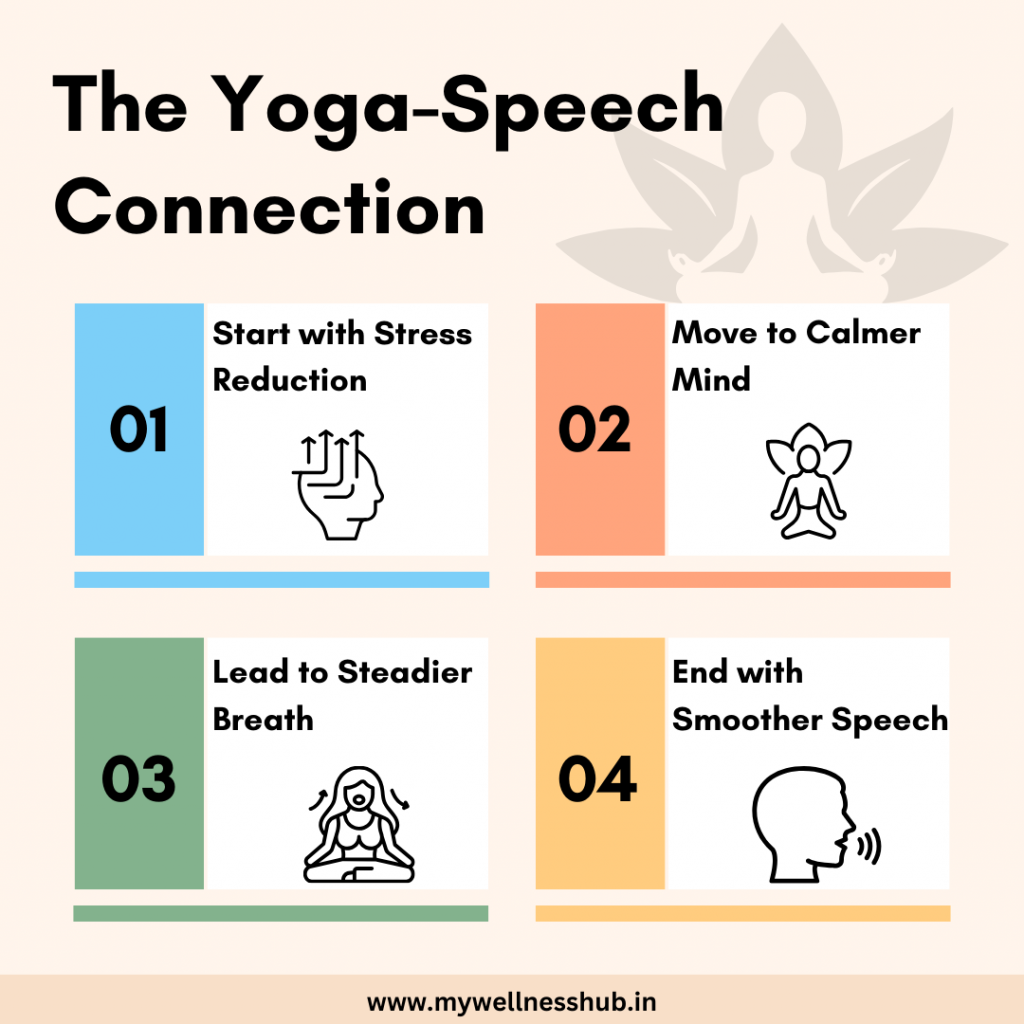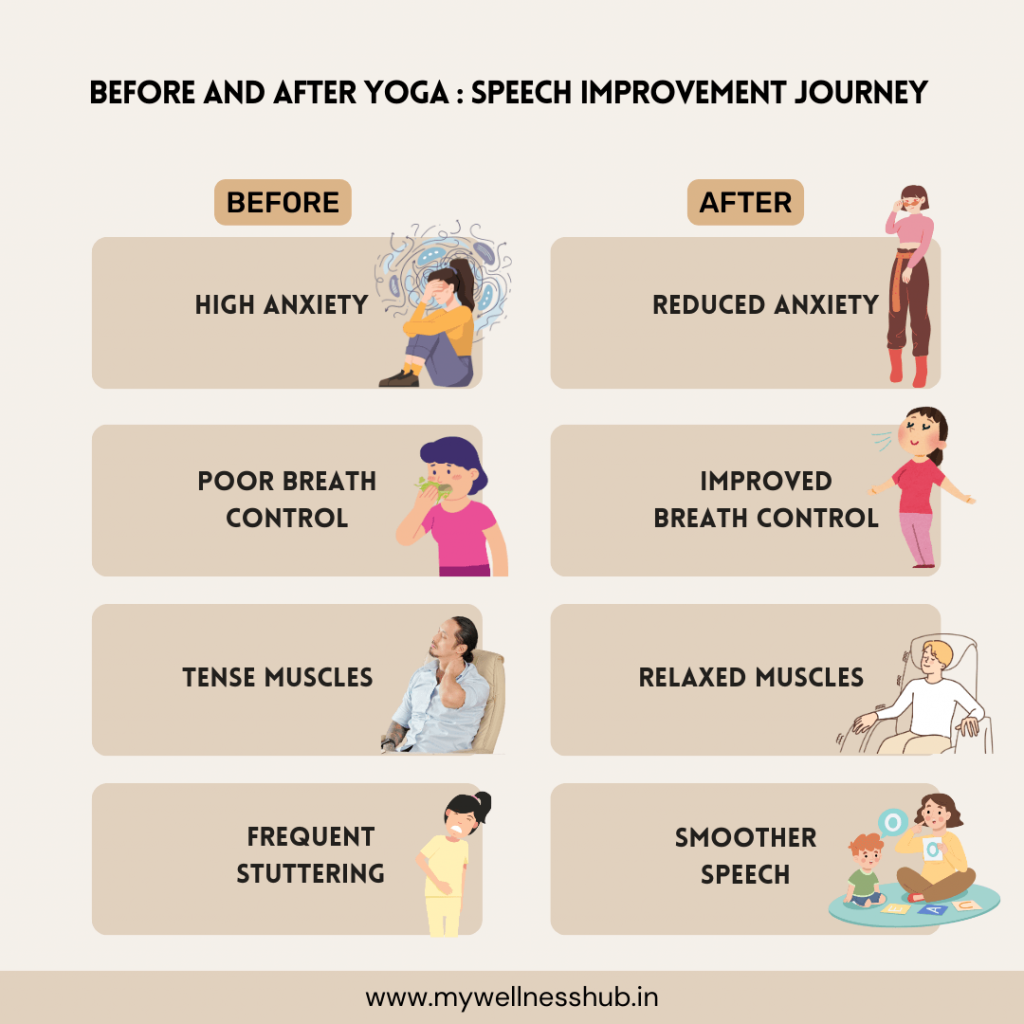Yoga for Better Speech: 12 Exercises to Help with Stuttering
By Wellness Hub
Last Updated: July 2, 2024
Stuttering often casts a shadow on one’s confidence and ease in social situations, presenting a challenge that goes beyond mere speech disruptions. This is where yoga comes into play, offering more than just physical wellness. Imagine a practice that not only improves your flexibility but also enhances your ability to communicate. We’re about to delve into the lesser-known yet promising benefits of yoga for improving speech fluency. Join us as we explore 12 transformative yoga exercises, designed to soothe the mind, strengthen speech muscles, and unlock the potential for smoother communication. Welcome to a path of tranquility that harmonizes body, mind, and speech.
Also Read: 7 Key Techniques for Overcoming Stuttering
The Connection Between Yoga and Speech Fluency
Yoga, a practice deeply rooted in ancient wisdom, offers more than just physical benefits; it’s a key to unlocking smoother speech and enhanced fluency. At its core, yoga strengthens the mind-body connection, encouraging a sense of balance and harmony within ourselves. This balance is particularly beneficial for those of us seeking to improve our speech fluency.

By integrating yoga into our routines, we’re not just stretching our bodies; we’re expanding our ability to communicate with ease and confidence. Through focused breathing exercises, or pranayamas, yoga teaches us to control our breath, a fundamental skill for managing speech flow and reducing stuttering. Asanas, or physical postures, improve posture and respiratory strength, both critical for clear and confident speech. Together, these elements of yoga cultivate a calm, focused state of mind, allowing for smoother, more fluent speech. In essence, yoga offers a pathway to improved speech fluency, empowering us to speak our truth with clarity and confidence.
Understanding Stuttering and Its Challenges
Stuttering, often perceived as a mere stumbling of words, is in fact a complex condition with layers that extend into the emotional and psychological realms of those affected. At its core, stuttering is characterized by involuntary repetitions, prolongations of sounds, syllables, or words, and even involuntary pauses in speech. This condition doesn’t discriminate, touching the lives of individuals across ages, though it most commonly begins in childhood. The roots of stuttering are multifaceted, intertwining genetic predispositions, neurological factors, and environmental influences.
The journey of someone who stutters is not just about grappling with the physical aspects of speech. The emotional and psychological impact is profound, weaving through every interaction and conversation. Imagine the frustration of struggling to express your thoughts fluidly, the anxiety of speaking in public, or the fear of judgment in social settings. Stuttering can cast long shadows over one’s self-esteem and social interactions, often leading to avoidance behaviors and a marked reduction in quality of life.
For more insights into autism spectrum disorder and its relationship with speech challenges, visit our dedicated section.
How Yoga Can Help
It’s not just an exercise; it’s a practice of integrating mind, body, and spirit, offering tools for managing stress and anxiety that often accompany stuttering.
The Role of Yoga in Managing Stress and Anxiety
Yoga, with its deep roots in mindful practices and physical well-being, offers a sanctuary from the whirlwind of stress and anxiety. For those who stutter, the stress response can exacerbate speech difficulties, turning a simple conversation into a battleground. Yoga’s emphasis on breathing and mindfulness invites a sense of calm to the forefront, dialing down the body’s stress response and creating a space where speech can flow more freely.
Breathing exercises (Pranayama), a cornerstone of yoga practice, teach us to harness control over our breath, a powerful tool for managing anxiety. Through regular practice, individuals learn to invoke a sense of calm in moments of stress, directly impacting their speech fluency.
Improving Muscle Coordination and Breath Control
Stuttering is not solely a battle of the mind; it’s also a physical one, where coordination and control over the muscles involved in speech are paramount. Yoga offers a holistic approach to enhancing this control. Asanas (postures) strengthen and relax the body’s musculature, including those vital for speech, promoting a more harmonious coordination between thought and expression.
Through targeted exercises, yoga nurtures an awareness of breath, a fundamental aspect often overlooked. For someone who stutters, mastering breath control can be transformative, providing a foundation for smoother, more fluent speech.
Learn more about how online speech therapy complements yoga for enhancing speech fluency.
Yoga Exercises to Enhance Speech Fluency
Through 12 yoga exercises designed to enhance speech fluency, each chosen for its unique ability to foster ease, control, and confidence in breathing and speaking.
1. Sahaj Shankh Mudra (Ease and Control for Breathing)
This simple hand gesture is known to improve breathing patterns and enhance vocal clarity. By sitting comfortably and adopting this mudra, you encourage deeper, more controlled breathing, setting a foundation for smoother speech.
2. Brahma Mudra (Strengthening Throat and Articulation Muscles)
Incorporate Brahma Mudra into your routine to work on the muscles around your throat and jaw. This exercise not only strengthens the muscles used in speech but also promotes relaxation and stress relief, crucial for individuals working on their fluency.
3. Simhasana (Lion Pose)
Release tension and unlock a more expressive vocal range with Simhasana. This powerful pose helps in reducing strain in the facial and throat muscles, encouraging freedom and fluidity in speech.
4. Vrikshasana (Tree Pose)
Find your balance and center with Vrikshasana. This posture enhances concentration and steadies the mind, which in turn, can lead to more controlled and confident speech.
5. Trikonasana (Triangle Pose)
Through the full-body stretch and coordination required in Trikonasana, experience relaxation and mental clarity. This pose encourages a harmonious connection between mind and body, essential for smooth communication.
6. Virabhadrasana (Warrior Pose)
Build strength and confidence in both posture and speech with Virabhadrasana. This dynamic pose boosts self-esteem and reduces anxiety, which can positively impact speech fluency.
7. Savasana (Corpse Pose)
Savasana offers deep relaxation and stress relief, key elements in managing stuttering. By calming the nervous system, it prepares the body and mind for improved speech production.
8. Sukshama Vyayama (Detailed Muscle Engagement for Speech Support)
This set of subtle exercises targets the facial and neck muscles involved in speech. Regular practice can lead to better control and coordination, supporting smoother speech.
9. Nadi Shodhana (Balanced Breathing)
Practicing Nadi Shodhana calms the mind, reduces stress, and improves focus. Balanced breathing is foundational for those seeking to enhance speech fluency, as it promotes a calm and centered state of being.
10. Bhastrika Pranayama (Energizing the Body)
Awaken your body and clarify your mind with Bhastrika Pranayama. This breathing exercise invigorates the entire system, reducing stress levels and improving control over breath, a vital aspect of fluent speech.
11. Ujjayi Pranayama (Controlled Breathing for Smoother Speech)
Known for its soothing sound and calming effect, Ujjayi Pranayama encourages a rhythmical pattern of breathing, essential for those aiming for smoother and more controlled speech.
12. Anuloma-Viloma Pranayama (Enhancing Respiratory Control)
Enhance your respiratory control and reduce stuttering with Anuloma-Viloma Pranayama. This practice balances the nervous system, supporting a steady flow of speech.
Yoga Pose, Benefits, and Practice Frequency
| Pose Name | Benefits for Speech | Recommended Frequency |
|---|---|---|
| Sahaj Shankh Mudra | Enhances breath control and vocal clarity | Daily |
| Brahma Mudra | Strengthens throat and vocal muscles | 3-5 times a week |
| Simhasana (Lion Pose) | Releases tension, improves articulation | Daily |
| Vrikshasana (Tree Pose) | Promotes balance and focus; aids deep breathing | 3-5 times a week |
| Trikonasana (Triangle Pose) | Encourages full-body coordination and relaxation | 3-5 times a week |
| Virabhadrasana (Warrior Pose) | Boosts confidence and posture; enhances lung capacity | 3-5 times a week |
| Savasana (Corpse Pose) | Reduces stress and anxiety; promotes relaxation | Daily |
| Sukshama Vyayama | Improves fine motor skills and facial muscle control | Daily |
| Nadi Shodhana | Balances the nervous system, reduces stuttering causes | Daily |
| Bhastrika Pranayama | Increases lung capacity, energizes the brain | Morning, daily |
| Ujjayi Pranayama | Controls breathing, calms the mind | Daily |
| Anuloma-Viloma Pranayama | Enhances respiratory control, reduces speech disfluencies | Daily |
Learn more: Oral Motor Exercises: Jaw Exercises for Effective Communication
Incorporating Yoga into Daily Life
Incorporate yoga into the activities you’re already doing. Practice deep breathing while waiting for the kettle to boil or do a few stretches while watching TV. This approach helps you weave yoga into the fabric of your day without it feeling like an additional task.
1. Be Patient and Kind to Yourself
Progress in yoga, like in speech therapy, is often gradual and requires patience. Celebrate the small victories, like feeling more relaxed, noticing slight improvements in speech, or simply enjoying the practice. Be compassionate with yourself on days when practice seems challenging.
2. Utilize Resources
Leverage the wealth of resources available to support your practice. From online tutorials and apps to yoga classes and books, there’s a plethora of tools at your fingertips. Wellness Hub offers a variety of resources to guide you on your journey, ensuring you have the support you need to practice effectively.
3. Engage with a Community
Joining a yoga community, whether online or in-person, can provide additional motivation and support. Sharing experiences, challenges, and successes with others can be incredibly uplifting and encouraging.
4. Practice Mindfulness
Remember, yoga is not just about the physical poses but also about cultivating mindfulness and a deeper connection with yourself. Carry the mindfulness you practice on the mat into your daily life. This heightened awareness can significantly impact your speech fluency and overall quality of life.
5. Reflect and Adapt
Regularly reflect on your practice and its impact on your speech and well-being. Be open to adapting your routine as you discover what works best for you. This personalization is key to maintaining a sustainable and enjoyable practice.
Yoga Practice Progress Tracker
| Week | Focus Area | Goal | Check-in |
|---|---|---|---|
| Week 1 | Introduction to Yoga & Basic Breathing Techniques | Familiarize with yoga & improve breath awareness | Track comfort with breathing techniques |
| Week 2 | Mastering Sahaj Shankh & Brahma Mudra | Enhance throat and vocal cord relaxation | Assess improvements in throat relaxation |
| Week 3 | Simhasana & Vrikshasana for Posture and Breath Control | Reduce tension & improve vocal clarity | Note changes in tension and vocalization |
| Week 4 | Integrating Trikonasana & Virabhadrasana for Confidence | Build confidence & reduce anxiety in speech | Self-evaluate confidence during speech |
| Week 5 | Deepening Relaxation with Savasana & Sukshama Vyayama | Achieve deep relaxation & stress reduction | Observe stress levels & relaxation depth |
| Week 6 | Enhancing Focus with Nadi Shodhana | Balance the nervous system & improve focus | Monitor focus during daily activities |
| Week 7 | Energizing Morning Routine with Bhastrika Pranayama | Energize body & mind, clearer speech focus | Feel energy levels & clarity in morning routine |
| Week 8 | Regulating Speech with Ujjayi & Anuloma-Viloma Pranayama | Achieve smoother, more controlled speech | Reflect on speech fluency and control |
Read more: Oral Motor Exercises: Exercises for Strengthening Cheeks

Conclusion
As we conclude our exploration of yoga for enhanced speech, remember that the journey extends beyond mastering exercises—it’s about embracing a holistic lifestyle with Wellness Hub. By integrating yoga into your daily routine, you achieve more than fluency; you cultivate mental balance and physical wellness. Wellness Hub is your ally, offering resources and support to enrich this journey. Together, let’s turn each word into a testament to your growth and harmony, proving that with consistent practice and the right guidance, anyone can transform their speech and achieve holistic health. Join us, and let every breath guide you to clearer, more confident communication.
Frequently Asked Questions:
1. How does yoga help with stuttering?
Yoga helps with stuttering by promoting relaxation, reducing anxiety, and improving breath control and posture. Regular practice of specific yoga exercises can enhance speech fluency by fostering a calm state of mind and strengthening the muscles involved in speech production.
2. What are the best yoga exercises for improving speech fluency?
Some of the best yoga exercises for improving speech fluency include Sahaj Shankh Mudra, Simhasana (Lion Pose), Vrikshasana (Tree Pose), and Ujjayi Pranayama. These exercises focus on breath control, muscle relaxation, and posture, which are key elements in achieving smoother speech.
3. Can yoga be a substitute for speech therapy?
While yoga is beneficial for enhancing speech fluency and reducing stuttering, it should complement rather than replace traditional speech therapy. Yoga can be integrated into a comprehensive treatment plan for stuttering, offering additional support alongside professional speech therapy.
4. How often should I practice yoga exercises to see an improvement in my speech?
Consistency is key when practicing yoga for speech improvement. A daily routine of 15-30 minutes can be effective in gradually enhancing speech fluency. It’s important to maintain regular practice and patience to observe significant benefits.
5. Where can I find resources and guidance for using yoga to improve my speech?
Wellness Hub offers a range of resources and guidance for individuals looking to use yoga as a tool for improving speech fluency. With expert tips, comprehensive yoga exercise guides, and support for holistic wellness, Wellness Hub can help you incorporate yoga into your speech improvement journey.
6. Does practicing yoga have immediate effects on stuttering and speech fluency?
While some individuals may notice minor improvements in their stress levels and breathing control relatively quickly, significant changes in speech fluency and stuttering reduction generally require consistent practice over time. Patience and regular yoga practice are essential for long-term benefits.
7. Can yoga exercises be customized for individuals with varying levels of stuttering?
Yes, yoga exercises can be tailored to meet the unique needs of individuals with different levels of stuttering. Wellness Hub provides personalized guidance and customized yoga routines that consider the severity of stuttering and individual preferences, ensuring an inclusive approach to improving speech fluency.
8. Are there any online resources or platforms where I can learn yoga for speech improvement?
Wellness Hub is an excellent online resource offering a variety of yoga exercises and routines designed to aid speech improvement. With detailed instructions and support, individuals can easily access and practice yoga exercises from the comfort of their home, making speech improvement more accessible and convenient.
9. How can I integrate yoga with my current speech therapy sessions?
To effectively integrate yoga with speech therapy, consider discussing your yoga practice with your speech therapist. They can offer advice on how to align yoga exercises with your therapy goals. Wellness Hub also provides insights on combining yoga with speech therapy to create a holistic treatment plan.
10. What are the mental health benefits of using yoga to address stuttering?
In addition to improving speech fluency, yoga helps reduce anxiety, stress, and depression, which are often associated with stuttering. The mindfulness and relaxation techniques inherent in yoga promote mental well-being, helping individuals feel more confident and less anxious about their speech.
About the Author:
Rajini Darugupally
M.Sc., Speech-Language Pathologist (9+ years of experience)
Rajini is a passionate and dedicated Speech-Language Pathologist with over 9+ years of experience, specializing in both developmental speech and language disorders in children and rehabilitation in adults. Driven by a desire to empower each individual to find their voice, Rajini brings a wealth of experience and a warm, genuine approach to therapy. Currently, at Wellness Hub, she thrives in a team environment that values innovation, compassion, and achieving results for their clients.
Book your Free Consultation Today
Parent/Caregiver Info:
Client’s Details:
* Error Message









